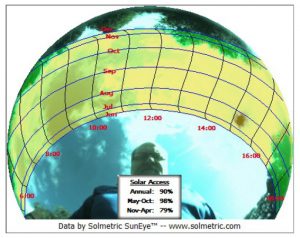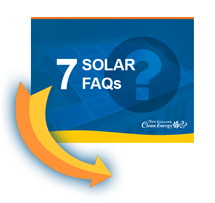Enough sun reaches the Earth to power the entire planet, as you may have heard. But can your home or business produce enough solar to meet your electricity needs? It depends on your roof size, and its TSRF. My what? you ask. Let me back up.
The “solar-friendliness” of your roof depends on factors including roof tilt (pitch), roof orientation (azimuth), and shade. These factors are measured using TOF, Solar Access and TSRF. Here’s what each of these terms means.
Tilt and Orientation Factor (TOF)
TOF measures how much sun your roof will get based on its tilt and orientation. TOF is expressed as a percentage of a roof with ideal tilt and orientation.
(FYI, tilt is measured in degrees relative to horizontal. And orientation is measured in degrees relative to North, with a south-facing roof measuring 180 degrees.)
Solar Access
Solar access measures how much sun your roof will get based on shading from nearby trees or buildings. Solar Access is expressed as a percentage of your roof with ideal shading conditions, i.e. no shade at all.
Total Solar Resource Fraction (TSRF)
 TSRF accounts for tilt, orientation and shade. In fact, TSRF can be calculated by multiplying the Solar Access and the TOF. It is expressed as a percentage of your roof with ideal tilt and orientation and no shade. (The image to the right is from a recent reading I took. That’s my reflection at the bottom — I’ve been the star of many a shade reading in my 12 years evaluating roofs.)
TSRF accounts for tilt, orientation and shade. In fact, TSRF can be calculated by multiplying the Solar Access and the TOF. It is expressed as a percentage of your roof with ideal tilt and orientation and no shade. (The image to the right is from a recent reading I took. That’s my reflection at the bottom — I’ve been the star of many a shade reading in my 12 years evaluating roofs.)
Clearly TSRF, which also factors in weather patterns for the location, is the most accurate and comprehensive of the three calculations of your roof’s solar-friendliness. It allows New England Clean Energy and other installers to give you accurate projections for your solar production, savings and income.
Relying solely on Solar Access or TOF is a mistake because the first doesn’t take tilt and orientation into account, and the second doesn’t take shade into account.
For example, a roof with 91% TOF and 69% Solar Access will have 63% TSRF. The first two numbers obviously sound better, but they are wrong. TSRF is the most accurate representation of how much solar your roof can convert into electricity.
A Note on Ground-Mounts
We can build ground-mounted solar energy systems with the best tilt and orientation for maximum energy production, so the TOF is essentially 100%. Shade and weather, however, will vary by site, which is why we always take a TSRF reading for ground-mounts.
More Terms
Insolation is often mentioned in TSRF, TOF and Solar Access explanations. It simply means how much sunlight your property gets over the course of a period in time. It is expressed in watt-hours per square meter.
Irradiance, on the other hand, measures how much sunlight your property gets in one instant. It is expressed in watts per square meter.
If you liked this article, you might also enjoy:
- STC vs. PTC: Why Solar Panel Testing Matters
- Tree Math: Solar vs. Trees, What’s the Carbon Trade-off?
- What’s in a Solar Production Estimate?


 Download our 7 FAQs
Download our 7 FAQs

